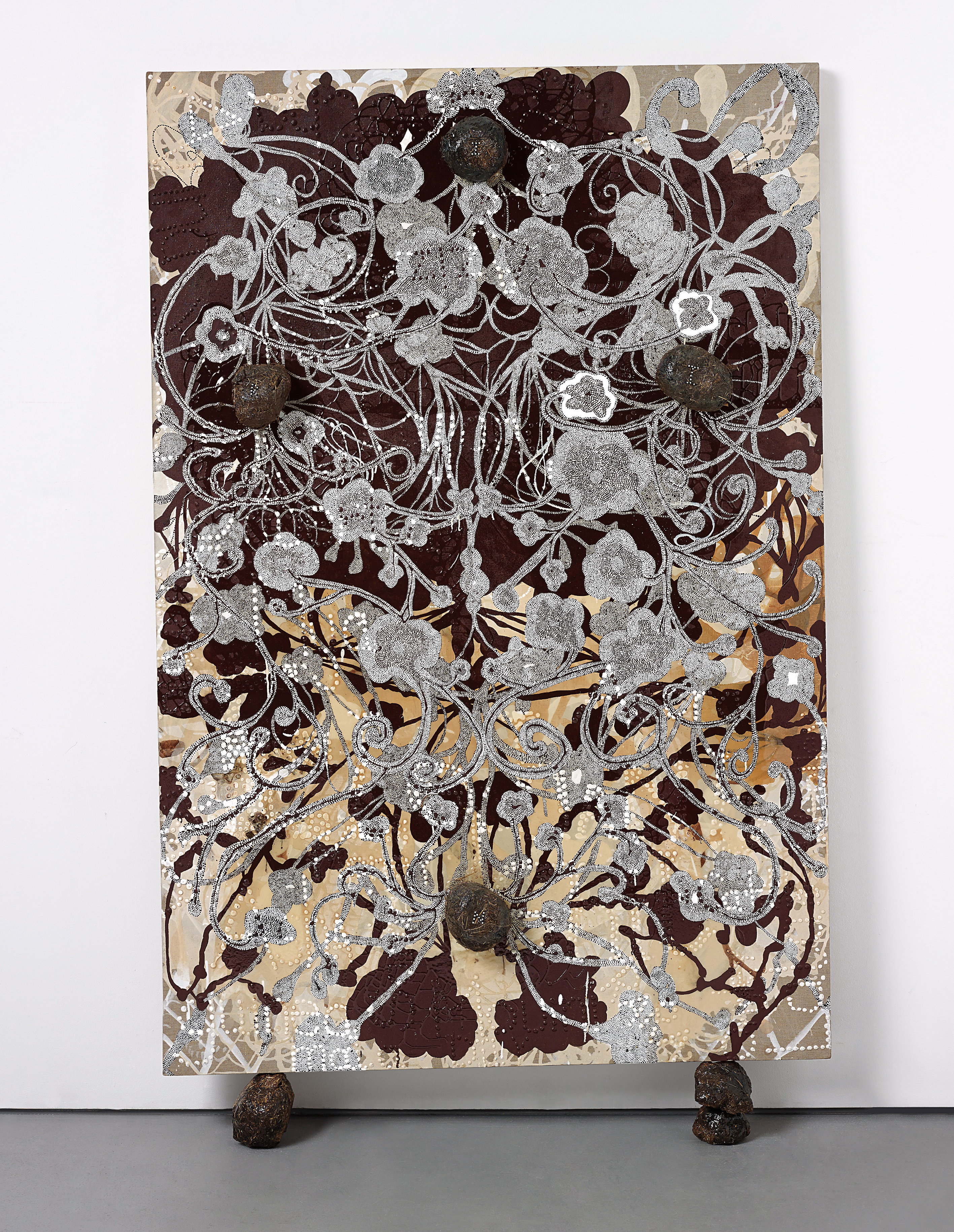

13Ο◆
Chris Ofili
Homage
acrylic, oil, polyester resin, map pins, elephant dung on linen
195 x 121.9 cm (76 3/4 x 47 7/8 in.)
Signed, titled and dated '"Homage" 1993-1995 Chris Ofili' on the stretcher.
Full-Cataloguing
Chris Ofili’s use of elephant dung in his paintings has not been without its detractors. His 1996 The Holy Virgin Mary, a painting of a black Madonna, featured an exposed right breast made of the varnished substance. When it was shown at the Brooklyn Museum of Art in 1999 as part of a group exhibition of artists in Charles Saatchi's coterie, Mayor Rudolph W. Giuliani was so outraged that he attempted to cut off all municipal funding to the museum, calling the painting ‘sick stuff.’ After seeing a photograph of The Holy Virgin Mary in the exhibition catalogue, the president of The Catholic League for Religious and Civil Rights issued a statement urging people to picket the museum. Ofili, who had recently won the Turner Prize, felt no need to defend his art. ‘The people who are attacking this painting are attacking their own interpretation, not mine. You never know what's going to offend people, and I don't feel it's my place to say any more.’ (Chris Ofili in Carol Vogel, ‘Chris Ofili: British Artist Holds Fast to His Inspiration,’ New York Times, 28 September 1999).
This quiet sense of authority pervades all of Ofili’s work. Often consisting in multiple layers of paint, resin, glitter, beads and other adornments, his style is uncompromisingly cultivated. He questions racial and cultural stereotypes with a scintillating eye for visual richness. The artist began incorporating elephant dung after a trip to Zimbabwe in 1992, as a natural vehicle for exploring the typecast material ‘otherness’ of African heritage in his art. ‘When a giraffe taller than the average house in Britain would walk by, it gave me that particular feeling of being shocked and simultaneously finding something beautiful. It gave me an excitement and a fear of the new.’ (Carol Vogel, ‘Chris Ofili: British Artist Holds Fast to His Inspiration,’ New York Times, 28 September 1999). He brought back some of the dung in his suitcase, and later sourced it from London Zoo – a telling transposition of the exotic that speaks to the accretions of meaning in migrant histories.
The present lot is an early and outstanding example of Ofili’s virtuosic craftsmanship. Letters and textual fragments, spelt out in meticulous dots of paint and in map pins purchased from a local grocery shop, invoke a swirling multiplicity of narratives. The dung balls are arranged in a form that imitates the crucifix, and spell out the Latin tag INRI: Iesus Nazarenus, Rex Iudaeorum. This translates as ‘Jesus the Nazarene, King of the Jews,’ and integrates Ofili’s Catholicism in provocative materiality. Meanwhile, the branching, organic pattern is reminiscent of batik print as much as William Morris wallpaper; the prehistoric cave paintings of Matobo National Park also find their way into intricate, almost psychedelic forms. It is a captivating apparition. As with many of his works, the canvas is perched atop spherical ‘feet’ made of dung; Ofili describes this as ‘a way of raising the paintings up from the ground and giving them a feeling that they've come from the earth rather than simply being hung on a wall.’ (Carol Vogel, ‘Chris Ofili: British Artist Holds Fast to His Inspiration,’ New York Times, 28 September 1999). Complex and diverse in significance, Homage is a postmodern tapestry that remains unabashedly beautiful.
This quiet sense of authority pervades all of Ofili’s work. Often consisting in multiple layers of paint, resin, glitter, beads and other adornments, his style is uncompromisingly cultivated. He questions racial and cultural stereotypes with a scintillating eye for visual richness. The artist began incorporating elephant dung after a trip to Zimbabwe in 1992, as a natural vehicle for exploring the typecast material ‘otherness’ of African heritage in his art. ‘When a giraffe taller than the average house in Britain would walk by, it gave me that particular feeling of being shocked and simultaneously finding something beautiful. It gave me an excitement and a fear of the new.’ (Carol Vogel, ‘Chris Ofili: British Artist Holds Fast to His Inspiration,’ New York Times, 28 September 1999). He brought back some of the dung in his suitcase, and later sourced it from London Zoo – a telling transposition of the exotic that speaks to the accretions of meaning in migrant histories.
The present lot is an early and outstanding example of Ofili’s virtuosic craftsmanship. Letters and textual fragments, spelt out in meticulous dots of paint and in map pins purchased from a local grocery shop, invoke a swirling multiplicity of narratives. The dung balls are arranged in a form that imitates the crucifix, and spell out the Latin tag INRI: Iesus Nazarenus, Rex Iudaeorum. This translates as ‘Jesus the Nazarene, King of the Jews,’ and integrates Ofili’s Catholicism in provocative materiality. Meanwhile, the branching, organic pattern is reminiscent of batik print as much as William Morris wallpaper; the prehistoric cave paintings of Matobo National Park also find their way into intricate, almost psychedelic forms. It is a captivating apparition. As with many of his works, the canvas is perched atop spherical ‘feet’ made of dung; Ofili describes this as ‘a way of raising the paintings up from the ground and giving them a feeling that they've come from the earth rather than simply being hung on a wall.’ (Carol Vogel, ‘Chris Ofili: British Artist Holds Fast to His Inspiration,’ New York Times, 28 September 1999). Complex and diverse in significance, Homage is a postmodern tapestry that remains unabashedly beautiful.